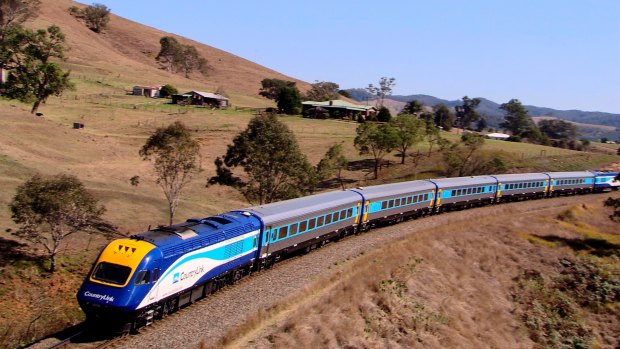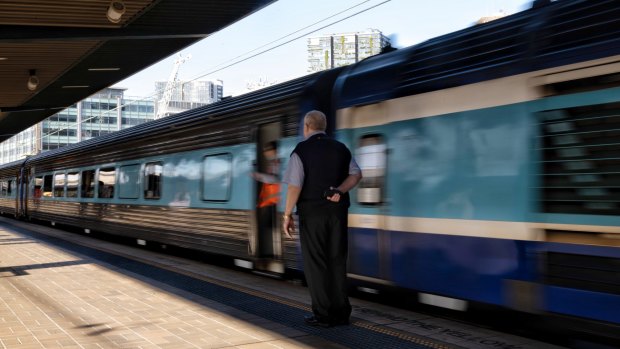This was published 1 year ago
The pros and cons of getting the XPT overnight train from Sydney to Melbourne
By Ben Grubb

Now that domestic airfares have skyrocketed, it can be cheaper to catch the train.
I've never really understood why people catch trains interstate, nor have I understood their appeal. They're slow, somewhat noisy, and have traditionally been of a similar cost to catching a plane.
They also have patchy mobile reception; no Wi-Fi to compensate for this; and no power outlets that can charge your phone or laptop. While I recognise most domestic flights don't have many of these features, you'd think such a long train journey would warrant them. Alas.
And so, with such a bad rap, I've avoided regional trains. Until now.

The XPT Train from Sydney to Melbourne leaving Central Station. Credit: Nick Moir
With high inflation and the cost of fuel rising, the economics have changed. If you booked a flight to Melbourne or Brisbane over the several years before COVID, it was often cheaper than taking the train. But now, domestic fares have skyrocketed, and it can sometimes be cheaper to catch the train.
After realising this, it made sense to give the slow ride a go - in one direction at least (I caught a plane back to Sydney in business class on points; I was unsure I could stomach the journey both ways.)
The overnight journey was surprisingly not awful, although I did fork out extra for first class that allowed me to recline 40 degrees - particularly helpful given I'm more than 190 centimetres tall (in economy, you get 28 degrees). I could've separately paid more for a sleeper cabin had one been available, but they've been booked out for a while.
The 959-kilometre journey allegedly has a top speed of 160km/h. But we live in Australia, where high-speed rail is a fantasy that has long been dreamed of and joked about. Because of "mud holes" caused by drainage problems, the track has historically been riddled with restrictions, meaning the speed is sometimes as slow as 20km/h to ensure safety. If it actually travelled 160km/h non-stop, it'd be there in under six hours. In reality, it takes just under 11.
To get to Melbourne's Southern Cross station, which is where you'll arrive when you get there, there are two options: leave Sydney's Central Station at 7.40am and arrive 6.30pm the same day or depart at 8.42pm and get in at 7.30am the next day. I chose the overnight train last month and arrived bang on time the next morning.
Food was available at reasonable prices from a buffet on board . There's a bathroom and shower onboard too.
Sleep-wise, it was very disruptive. I got roughly four two-hour naps in. When we stopped at regional stations – there are multiple stops, allowing you to alight along the way; something you can't do on a plane – I often found myself waking up. I also woke up a few times when the guy sitting behind me bumped (or hit ... unsure) my headrest (I was probably snoring, sorry dude). Thankfully, I had my phone to entertain me (no, I didn't use the journey to disconnect), plus I brought a laptop to charge it before I arrived.
On the plus side, you do get to see the countryside as the sun rises - plus you emit fewer carbon emissions. A single flight from Sydney to Melbourne (705 kilometres) creates just under 100 kilograms of greenhouse gas. The same trip by train generates only 16. Checked-in luggage is also more generous than most airlines: 2 x 20 kilograms. You can also take up to five kilograms of hand luggage. I definitely took more than that in hand luggage, but no one checked.
Would I do it again? Only one-way. At the end of a long weekend in Melbourne, I was exhausted.
While prices remain high, it's likely train travel will be used more.The person travelling next to me said she and her two travel companions were also getting the train for the first time because of the high cost of airfares.
A Transport for NSW spokesperson says the most recent figures during the month of October show patronage is more than double that of February 2022 and similar to pre-pandemic levels. December's patronage levels are reaching close to pre-COVID levels too. As a temporary measure, the Melbourne XPT has been increased from five to six carriages.
An "economy saver" ticket to Melbourne on a NSW TrainLink eXpress Passenger Train, or XPT, costs just $78.16 during the middle of the week, or up to $93.79 on busier days like Fridays.
You can save even more by getting a NSW TrainLink "discovery" pass, which provides unlimited travel that lasts anywhere from 14 days to six months and costs between $232 and $420 for adult economy seats and $300 and $550 for first class.
Considering the minimum cost of a flight to Melbourne was $289 on the Saturday I wanted to arrive, I'll catch the train again if the prices don't come down. Another added benefit was arriving in Melbourne's CBD without having to pay another $20 to get the SkyBus from Melbourne Airport had I caught a flight.
Correction: An earlier version of this story said you could not take your own food or drink (except water) on board the train. You can take your own food and non-alcoholic beverages on board.
Sign up for the Traveller Deals newsletter
Get exclusive travel deals delivered straight to your inbox. Sign up now.